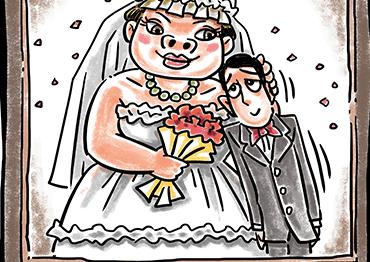ne of the biggest differences between Chinese and Canadian marriage ceremonies is the role of the wedding photo.
In my country, it is traditional for the wedding party to slip off to a scenic location after the ceremony, face the camera and smile for a series of pictures -the bride and groom, bride groom and parents, bride and her friends, and so on. After this, everyone proceeds to the wedding dinner.
By contrast, in China the wedding photos are a major production. They are shot well before the wedding, often in a series of exotic locations. Each shot might feature a different costume - sometimes in a tuxedo and Western wedding dress, sometimes in traditional Chinese clothes, and sometimes in whatever crazy idea the photographer cooks up.
Chinese wedding photo albums are almost always entertaining, fanciful and zany. Sometimes they use trick photography. One of my favorite shots was a King Kong-sized bride smiling and dangling her hapless miniature husband by her fingertips in mid-air. In another, a husband posed traditionally with his conservatively dressed wife by his side, furtively looking at another woman, who was his wife dressed in a sexy outfit.
One woman I met had a life-sized cutout of her and her American groom posing on the sand in their beach-wedding outfits. This had shades of Charles Dickens, because, she said, her husband was dead. Her friends later whispered to me that he had “disappeared” with no explanation.
My wife and I live in Dali, one of the most scenic spots in China. As a result, it’s almost impossible to go into town or to the lake without encountering van-loads full of brides and grooms getting their photos taken.
Each van often has two or three couples, and they go to a series of fixed spots wearing outfits borrowed from the photographer. Each couple waits their turn, tended to by a professional makeup person.
We decided to take our photos in our beautifully renovated courtyard home, and at a secluded, nearby waterfall on a mountain that few people know about.
Xin’s mother requested a photo montage, for the giant video screens at the giant church in Shenyang where we were to be married.
We picked eight of the best shots and sent them. Following my mother-in-law’s wishes, we also used a photo of us at the government office holding up our official government wedding certificates. This is because in China, the legal marriage procedures, conducted at government office, are often done weeks or months apart from the wedding ceremony.
The focus of weddings in China is in general different from the focus back home.
The weddings I’ve attended back home focus on the bride’s desires, and sometimes last for two days, or even longer.
For example, one wedding I attended for an outdoorsy couple took place in the wilderness. Everyone stayed in tents, and instead of walking down the aisle, the bride arrived by canoe.
My sister was married on a beach in Thailand, and the ceremony involved monks chanting for an uncomfortably long 25 minutes.
Frequently, at a Chinese wedding, a professional master of ceremonies conducts the event on a stage in a banquet hall. If the family has lots of money, it often looks like an elaborate television set, with many lights, a wonderful sound system, and an abundance of artificial flowers and sculptures of romantic animals like swans and unicorns.
A week before the wedding, we received a call from Xin’s uncle, who played a major role in organizing the wedding, asking if we wanted four photographers on the wedding day or two.
Xin pointed out her recently married cousin had four. I imagined there was some subtle competition going on. Nonetheless, I said two should be more than enough, although I had actually just planned to ask everyone to take photos with their mobile phones and share them.
Since we got married at a church in the morning, the photographers impressively edited all the video before our evening wedding banquet.
In lieu of the on-stage ceremony, the footage was played before their scores of important colleagues and family members in a loop on a video screen.
At the entrance to the hall was a lovely photo of us walking down the aisle out of the church together, prominently featuring in the upper corner the large video screen showing our official government wedding photo.
In the end, the photographers gave us this video, and a mere 18 photos. None of the photos had Xin walking down the aisle, the exchange of vows, or portraits of the bride and group with various family members, like one would expect in Canada.
I suppose we should have gone for four photographers after all.
Like many other mixed Chinese-Western couples, we held a separate party that included dancing late into the evening. In the end, we got the best of all worlds.

 Old Version
Old Version